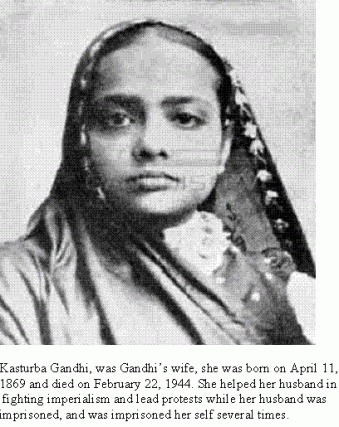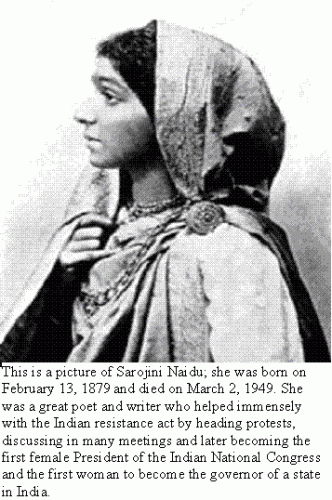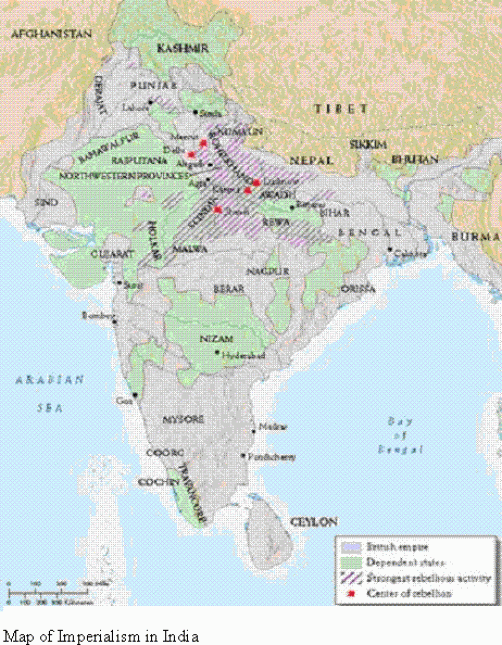Women Fighting Imperialism
During the time of the British Raj Gandhi fought first for local rule in the British Empire, and later a complete separation between England and India, he had many male supporters who participated in his efforts. But males were not the only ones to protest against the British Empire, women lead and participated in protests against the British. Whether they had their husbands permission or not, whether they were expected to or not, whether it went against their culture and religion or not the women of India stood up for what they felt was right and they helped win back India with nonviolence. Although the Indian male supporters of Gandhi were key components of the effectiveness of his peaceful actions, the success of Gandhi would not have been possible without the assistance of the Indian women.

Women fought for many reasons, family, up bringing, or a personal since of justice among them. Some women were expected to help in the protests by their husbands, fathers, or even grandfathers; an example of this is Gandhi’s wife, “Gandhi's wife, Kasturbai, led women protesters in picketing liquor shops after her husband's arrest” (Walsh). Kasturbai lead women in many other protests and was a very active member of the Women's Swadeshi League helping to spin thread with which to make cloths for her and her family. Sarojini Naidu had a very similar story, she fought because she had had experiences with the Empire from her earliest childhood memories and she knew in her heart that what she fought for was right; “Both parents were devoted to the promotion of education for girls and women and founded the Girls' College, which was affiliated with Osmania University, later called Nizam's College. The intellectual and artistic stimulation in Naidu's home enhanced her development into an extraordinary and multifaceted person” (Sarojini Naidu). This led her to become one of the primary leaders of the rebellion.

Women participated in things such as protests, complaint meetings, boycotts, and for some extremist women terrorism. There were many protests that were led by women not men; there were even some that men did not attend all together. By protesting themselves and not simply letting their men folk do all of the opposition the women of India made a statement to the British Empire, they said that India was not a country made only of men but that the women could be active to and that they opposed the empire. Though few would have admitted it at the time the women were a dangerous and persistent enemy that the British rule could not afford to have against them. The women were willing to cast aside all tradition for what they felt was right and just, “In the north Indian cities of Allahabad, Lucknow, Delhi, and Lahore, middle-class women, sometimes 1,000 at a time, participated in public demonstrations, even appearing in public on occasion without veils” (Walsh). Women also instigated and attended meetings to discuss the injustice of the foreign rule, “Between imprisonments, however, she [Sarojini Naidu] attended the second session of the Round Table Conference with Gandhi in an attempt to reach an agreement with the British government to secure Indian independence” (Sarojini Naidu). Boycotts were particularly common among the women because the less severe types did not often result in arrest, so many women aided in boycotts doing everything from avoiding buying certain un-necessary goods to openly making and selling local goods in protest; ”In Bombay, where the numbers of women protesters were the greatest, the Rashtriya Stree Sangha (National Women's Organization) mobilized women to collect seawater for salt, picket toddy shops, and sell salt on the street… In Madras the elite Women's Swadeshi League supported spinning, the wearing of khadi, and the boycott of foreign goods…” (Walsh). In even more severe cases women were known to act as terrorists and assassins even though most women looked down upon the violence that those types of defiance involved, “In Bengal middle-class women not only courted arrest but also participated in terrorist activities” (Walsh). No matter how sever however there were often negative repercussions for the women involved.

Women were punished by the imperial government just as were men but in some cases the worst punishment for women came not from their government but their families, “Not all husbands approved their wives' activities, however. In Lahore one husband refused to sanction the release of his jailed wife; she had not asked his permission before leaving home” (Walsh). Some women spent much of their time in jail and came out only long enough to lead the next protest, “Like most of the other nationalist leaders, Naidu was jailed for her activities in 1930, 1932, and 1942-1943.” (Sarojini Naidu). These negative repercussions however hampered women no more then they did men, in this instance women proved to the world and particularly the British Empire that women were indeed just as capable as men.
Without the support of the women one third of the people actively protesting in one way or another would have been absent and with out those prominent numbers the idea that India may not have had a peaceful revolution is a realistic one. Thought the hardships were daunting the women of India stood up for what they felt was right and through their efforts combined with that of their male counterparts India was freed.
-Diana Harris
Bibliography
"Sarojini Naidu." World History: The Modern Era. 2009. ABC-CLIO. 31 Mar. 2009 <http://www.worldhistory.abc-clio.com>.
Walsh, Judith E. "Gandhi and the nationalist movement in India.” India, A Brief History. New York: Facts On File, Inc., 2006. Modern World History Online. Facts On File, Inc. 31 Mar. 2009. <http://www.fofweb.com/>.

